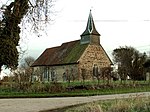RAF Rivenhall
Airfields of the 9th Bombardment Division in the United KingdomAirfields of the IX Fighter Command in the United KingdomMilitary units and formations established in 1943Royal Air Force stations in EssexRoyal Air Force stations of World War II in the United Kingdom ... and 1 more
Use British English from May 2013

Royal Air Force Rivenhall or more simply RAF Rivenhall is a former Royal Air Force station located in Essex, England. The airfield is located approximately 4 miles (6.4 km) south-southeast of Braintree, Essex, England. Opened in 1942, it was used by both the Royal Air Force and United States Army Air Forces. During the war, it was used primarily as a combat airfield with various fighter and bomber units. After the war, it was closed in 1946 and kept in reserve until 1956. Today, the remains of the airfield are located on private property with the northern half being turned into a quarry.
Excerpt from the Wikipedia article RAF Rivenhall (License: CC BY-SA 3.0, Authors, Images).RAF Rivenhall
Sheepcotes Lane, Essex
Geographical coordinates (GPS) Address Nearby Places Show on map
Geographical coordinates (GPS)
| Latitude | Longitude |
|---|---|
| N 51.855277777778 ° | E 0.63972222222222 ° |
Address
Sheepcotes Lane
CM77 8ER Essex
England, United Kingdom
Open on Google Maps






